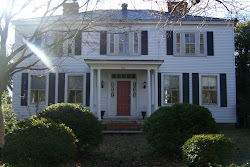We may have a rare and blight-free American Chestnut tree in the front yard. We have been told by several people that it is an American Chestnut tree, but a bit of research on the subject has revealed that these are very rare. American Chestnuts were native to eastern North America and they were an important timber tree when they were plentiful. In the early 1900's, a blight that was present on Asiatic Chestnut trees was accidently introduced to North America through imported trees - the blight is said to have killed over 3 billion American Chestnut trees. Some resources say that there are fewer than 100 surviving American Chestnut trees larger than 24 inches in diameter within the former range of these trees. If ours is an American Chestnut, it's a BIG one:
The tree is over 9 feet in circumference:
There are plenty of blight-resistant Chinese and Japanese Chestnut trees, which are similar to the American Chestnut, so it is possible that ours is some other species. How to tell? The American Chestnut Foundation , which has the mission of restoring the American Chestnut tree to its natural range through research and "back crossing" techniques offers a testing program for people who think they may have found an American Chestnut Tree. We've been waiting for spring to arrive and our tree to leaf out so we could send our sample in for testing. With the tree now fully leafed out, this week we carefully collected our leaf and twig and burr samples....
...followed the instructions for packing and shipping, and sent them in for testing. Now we wait for the official verdict in three to six weeks. In the meantime, tell us what you think: check out the close-up of our tree's leaves, below, and compare these to the leaves posted on The American Chestnut Foundation website
Stay tuned to find out if it is an American Chestnut!





